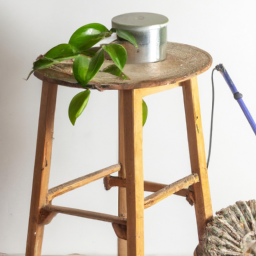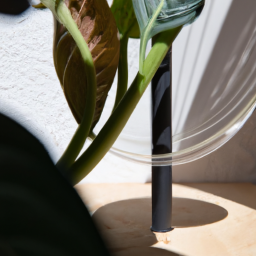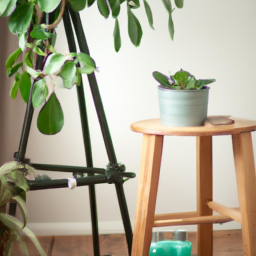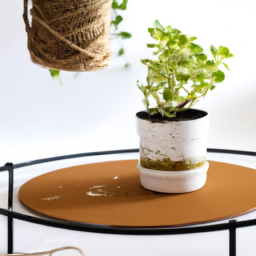
Are you looking for a creative way to showcase your beloved houseplants? Look no further than this blog post on Plant Stand DIY: Elevate Your Plants in Style. Whether you’re a seasoned DIY enthusiast or just starting out, creating your own plant stands can add a touch of personality and elegance to your indoor or outdoor space. Say goodbye to boring, plain pots sitting on the floor and say hello to a stylish and functional way to display your greenery. In this post, we’ll share some inspiring ideas, step-by-step instructions, and helpful tips to help you elevate your plants in style with DIY plant stands. So, grab your tools and let’s get started on this exciting journey of plant stand creation!
Benefits of Using Plant Stands for Indoor Gardening
Introduction
Indoor gardening has gained immense popularity in recent years, and for good reason. Not only does it bring a touch of nature into our homes, but it also offers numerous benefits for our overall well-being. One essential element of indoor gardening that often goes unnoticed is the use of plant stands. These simple yet stylish structures not only elevate the aesthetic appeal of our plants but also provide a range of practical advantages. In this article, we will delve into the benefits of using plant stands for indoor gardening and explore how they can transform your plant-filled space into a stunning oasis.
Enhanced Aesthetics
One of the primary reasons why plant stands have become a must-have for indoor gardeners is their ability to enhance the overall aesthetics of any space. By elevating your plants, these stands create a visually appealing display that adds depth and dimension to your indoor garden. Whether you opt for sleek and modern designs or rustic and vintage-inspired ones, plant stands come in a wide variety of styles, materials, and colors to suit any interior decor. With the right plant stands, you can effortlessly transform a plain corner into a captivating focal point that showcases the beauty of your beloved plants.
Furthermore, plant stands provide an opportunity for creative expression. You can mix and match different types of stands to create a unique and personalized arrangement. Experiment with varying heights, shapes, and textures to create an eye-catching display that reflects your personal style. The possibilities are endless, allowing you to curate a stunning indoor garden that is truly one-of-a-kind.
Moreover, plant stands offer the flexibility to rearrange your plants whenever you desire. Unlike traditional pots placed directly on the floor or tabletops, plant stands can be easily moved around, allowing you to experiment with different layouts and designs. This versatility ensures that your indoor garden remains dynamic and constantly evolving, keeping your space fresh and exciting.
Improved Plant Health
Aside from their aesthetic appeal, plant stands also contribute to the overall health and well-being of your plants. Elevating your plants off the ground promotes better air circulation, which is crucial for preventing the growth of mold, mildew, and other harmful organisms. Proper air circulation ensures that your plants receive adequate ventilation, reducing the risk of diseases and promoting healthier growth.
In addition, plant stands allow for better drainage. Excess water can easily accumulate at the bottom of pots when placed directly on surfaces, leading to root rot and other water-related issues. By elevating your plants, plant stands ensure that water drains properly and prevents waterlogging. This helps maintain optimal moisture levels in the soil, preventing water-related stress and promoting healthier root systems.
Furthermore, plant stands provide an opportunity to position your plants in optimal light conditions. Different plants have varying light requirements, and by using plant stands, you can easily adjust the height and position of your plants to ensure they receive the right amount of sunlight. This flexibility allows you to create microclimates within your indoor garden, accommodating a diverse range of plants with varying light preferences.
Space Optimization
Another significant advantage of using plant stands is their ability to optimize space in your indoor garden. With limited floor space, it can be challenging to accommodate a growing collection of plants. Plant stands offer a practical solution by utilizing vertical space effectively. By elevating your plants, you can create multi-tiered displays, maximizing the number of plants you can showcase in a limited area.
In addition to saving space, plant stands also provide an opportunity to organize your indoor garden more efficiently. By categorizing plants based on their size, light requirements, or water needs, you can create a visually pleasing and organized display. This not only makes it easier to care for your plants but also creates a harmonious and balanced aesthetic.
Furthermore, plant stands can be strategically placed to create visual separation in open floor plans or large rooms. By using tall plant stands, you can divide the space into distinct areas, adding structure and definition to your interior design. This can be particularly useful in studio apartments or open-concept living spaces where delineating different zones can be challenging.
Conclusion
Plant stands are more than just decorative elements for your indoor garden. They offer a range of benefits that enhance both the aesthetics and health of your plants. From creating visually appealing displays to optimizing space and promoting better plant growth, plant stands are a valuable addition to any indoor gardening setup. So, why not elevate your plants in style and transform your space into a lush oasis that brings nature indoors?

Step-by-Step Guide to Building Your Own Plant Stand
Introduction
Welcome to the ultimate guide on building your own plant stand! Elevating your plants in style not only adds a touch of elegance to your indoor or outdoor space but also helps improve air circulation and sunlight exposure for your beloved green friends. In this step-by-step guide, we will walk you through the process of creating a unique and personalized plant stand that will showcase your plants in the best possible way. So, let’s get started!
Materials and Tools
Before we dive into the construction process, let’s gather all the necessary materials and tools. Here’s a list of what you’ll need:
- Wooden boards (choose the type and size based on your design preferences)
- Saw (circular saw or hand saw)
- Sandpaper (medium and fine grit)
- Wood screws
- Drill
- Measuring tape
- Pencil
- Wood glue
- Paint or stain (optional)
- Paintbrush or sponge
Design and Measurements
Now that you have all the necessary materials and tools, it’s time to decide on the design and measurements of your plant stand. Consider the available space, the number and size of plants you want to display, and your personal style preferences. Here are a few design ideas to inspire you:
- A-frame plant stand
- Multi-tiered plant stand
- Hanging plant stand
- Corner plant stand
Once you have chosen a design, grab your measuring tape and pencil to mark the dimensions of each component. Take into account the height, width, and depth of the plant stand, as well as the size of the shelves or platforms where your plants will rest. It’s essential to ensure stability and proper weight distribution to prevent any accidents.
Construction Process
Now that you have your design and measurements ready, it’s time to start building your plant stand. Follow these step-by-step instructions:
1. Cutting the Wooden Boards
Using a saw, carefully cut the wooden boards according to the measurements you marked earlier. Remember to wear protective goggles and gloves while cutting to ensure your safety. Take your time to make precise cuts, as they will determine the overall stability and aesthetics of your plant stand.
2. Sanding the Boards
Once the boards are cut, use sandpaper to smooth out any rough edges or surfaces. Start with medium-grit sandpaper to remove any splinters or imperfections, and then switch to fine-grit sandpaper for a polished finish. Sanding not only enhances the appearance of the wood but also prevents any potential injuries from sharp edges.
3. Assembling the Components
Now it’s time to assemble the various components of your plant stand. Begin by attaching the legs or support beams to the base using wood screws and a drill. Make sure to align everything properly and use a level to ensure the stand is balanced. Next, attach the shelves or platforms at the desired heights, securing them with wood screws and wood glue for added stability.
4. Finishing Touches
Once the structure of your plant stand is complete, you can add some finishing touches to make it truly unique. Consider painting or staining the wood to match your existing decor or to create a bold statement piece. Apply the paint or stain evenly using a paintbrush or sponge, and allow it to dry completely before placing your plants on the stand.
Conclusion
Congratulations! You have successfully built your own plant stand from scratch. By following this step-by-step guide, you have not only elevated your plants in style but also unleashed your creativity and craftsmanship. Remember to regularly maintain and care for your plant stand to ensure its longevity. Now it’s time to enjoy the beauty of your plants showcased on your personalized plant stand!
Happy gardening!

Plant Stand DIY: Elevate Your Plants in Style
Are you a plant lover looking to add a touch of style to your indoor or outdoor space? Look no further! In this guide, we will explore creative ideas for stylish plant stand designs that you can easily make yourself. Elevate your plants in style with these DIY projects that are not only functional but also aesthetically pleasing.
1. Wooden Ladder Plant Stand
A wooden ladder can be transformed into a unique and eye-catching plant stand. Start by sanding down the ladder to remove any rough edges or splinters. Then, choose a paint color that complements your space and gives the ladder a fresh look. Once the paint is dry, position the ladder against a wall or in a corner and place your potted plants on each step. This design not only adds height and dimension to your plant display but also creates a rustic and charming atmosphere.
For added stability, you can secure the ladder to the wall or floor using brackets or hooks. This will ensure that your plant stand remains sturdy and safe.
If you want to take it a step further, you can also attach small wooden shelves to the ladder steps. These shelves can hold smaller plants or decorative items, adding even more visual interest to your plant display.
2. Geometric Wire Plant Stand
If you’re a fan of modern and minimalist designs, a geometric wire plant stand might be the perfect choice for you. Start by gathering wire mesh or wire grid panels, which can be easily found at hardware stores. Cut the panels into desired shapes, such as squares, triangles, or hexagons, using wire cutters.
Next, use pliers to bend the edges of the wire panels to create a three-dimensional shape. Make sure to leave an opening at the top where you can place your potted plant. You can also spray paint the wire stand in a color of your choice to match your interior or exterior decor.
Once the paint is dry, place your potted plants inside the wire stands, and arrange them in a visually pleasing way. The geometric shapes of the stands will add a contemporary and artistic touch to your plant display, making it a focal point of any room or outdoor area.
3. Repurposed Furniture Plant Stand
Why not give new life to an old piece of furniture by turning it into a plant stand? Look for items such as vintage stools, side tables, or even chairs that you no longer use or are in need of a makeover. Clean the furniture thoroughly and, if necessary, sand it down to remove any imperfections.
You can choose to paint the furniture in a single color or get creative with patterns or designs. Consider using stencils or tape to create unique patterns or color combinations. Once the paint is dry, place your potted plants on top of the furniture, utilizing different levels or surfaces.
This repurposed furniture plant stand adds character and charm to your space while also being a sustainable and eco-friendly option. It’s a great way to showcase your plants while giving a second life to an old piece of furniture.
There you have it – three creative ideas for stylish plant stand designs that you can easily make yourself. Whether you prefer a rustic ladder stand, a modern wire stand, or a repurposed furniture stand, these DIY projects will elevate your plants in style. Get creative, have fun, and enjoy the beauty of your elevated plant display!
Here’s the Summary Snapshot
Are you looking for a creative way to display your beloved plants? Look no further! In this blog post, we will guide you through a fun and stylish DIY project: creating your own plant stand. Elevating your plants not only adds a touch of elegance to your space but also provides better visibility and allows for proper drainage. So, let’s roll up our sleeves and get started on this exciting project!
To begin, gather your materials. You’ll need wooden boards, screws, a saw, sandpaper, and a drill. Once you have everything ready, measure and cut the boards according to your desired plant stand dimensions. Sand the edges to ensure a smooth finish. Next, assemble the stand by screwing the boards together. Don’t worry if you’re not a seasoned DIY-er; this project is beginner-friendly! Finally, give your plant stand a personal touch by painting or staining it to match your decor. With just a few simple steps, you’ll have a beautiful plant stand that will showcase your plants in style. So, why wait? Let’s get creative and elevate your plants to new heights!
Frequently Asked Questions (FAQ):
Q1: What materials do I need to make a DIY plant stand?
A1: To make a DIY plant stand, you’ll need a few basic materials such as wood boards, screws, a drill, sandpaper, a saw, and a measuring tape. Additionally, you may want to gather paint or stain if you wish to add a personal touch to your plant stand.
Q2: How do I choose the right design for my DIY plant stand?
A2: When selecting a design for your DIY plant stand, consider the overall style of your home or outdoor space. You can opt for a modern, minimalist design, a rustic farmhouse look, or even a bohemian-inspired stand. Take into account the size and weight of your plants as well, ensuring the stand can support them adequately.
Q3: Are there any safety precautions I should take while building a plant stand?
A3: Safety should always be a priority when undertaking any DIY project. Make sure to wear protective gear such as safety goggles and gloves. When using power tools, follow the manufacturer’s instructions and take necessary precautions. It’s also important to work in a well-ventilated area and keep children and pets away from the construction site.
Q4: Can I customize the size of my DIY plant stand?
A4: Absolutely! One of the advantages of making your own plant stand is the ability to customize it to your specific needs. You can adjust the height, width, and number of tiers to accommodate the size and quantity of your plants. Just be sure to take accurate measurements and make appropriate adjustments to the materials and design.
Q5: How do I maintain and care for my DIY plant stand?
A5: To keep your DIY plant stand in good condition, it’s important to regularly inspect it for any signs of wear or damage. Depending on the material used, you may need to apply a protective sealant or paint to prevent moisture damage or fading. Clean the stand periodically by wiping it with a damp cloth or using a mild soap solution. Additionally, consider moving the stand to different locations to ensure your plants receive adequate sunlight and airflow.

Lisa Chen is a seasoned indoor gardening expert and the author of several bestselling books on the topic. With a background in horticulture and urban farming, Lisa is dedicated to helping urban dwellers embrace the joys of cultivating green spaces indoors. Her detailed guides and hands-on tips empower readers to transform their living spaces into thriving plant sanctuaries.


